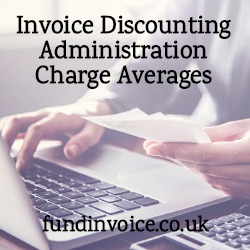- 05 Nov
Invoice Discounting Service Charge Average Percentage
Invoice discounting service charge is often the term people use when referring to the "administration charge" made for invoice discounting services. It is the percentage of your turnover that you pay the funder to use the service.
GET A QUOTE WITHOUT OBLIGATION (and no impact on your credit score).
Read about how the costs are made up and what typical costs will be.

Comparing Fees
To compare the fees between providers quoted for the same customer situation, we estimated the facility usage and used that to calculate estimated fees for our prospective customer. We used the same projected turnover and facility usage projections across all providers, making the comparison fair.
A service charge, or admin fee, is the "headline rate" that many people use to compare different invoice discounting offers, often ignoring the other charges that can form a large percentage of the overall costs.
We have undertaken a lot of research comparing prices between different invoice discounters, and we identified an 86% difference between the cheapest invoice discounting companies and the most expensive ones.
Invoice Discounting Average Service Charge Percentage
Looking at those results, I have identified the percentage of the charges quoted that were service charges rather than discount charges (any other additional fees were ignored for this comparison).
For normal, recourse-style confidential invoice discounting, the service charge represented 59% of the total fees quoted by the provider. Across the quotes that we obtained for a given customer, the range of quotes included service charges accounting for between 49% and 66% of the total cost (with the remainder being discount charges).
Average Charges For Protected Invoice Discounting (PID)
Looking at the quotes received for non-recourse style, protected invoice discounting (also called PID), the service charge accounted for 69% of the total fees quoted, with the range being from 59% to 75%.
Comparing Quotes
We often see examples of customers comparing quotes based on either just service charges (admin fees) or discount charges - which works similarly to interest, hence, people are often drawn to comparing that figure as you might for a loan or overdraft. What these results show is that both service charges and discounts need to be taken into consideration, as they both tend to account for significant proportions of the costs that you will be quoted for invoice discounting.
The wide ranges within the results show that failing to consider one or other elements could result in a completely misleading comparison of the fees between providers. My recent post about another example of how fees are broken down may be of interest to you. It was an extreme case where 82% of the fees were service charges, but the customer was hung up on getting the lowest discount rate when that had the least influence on the bottom-line cost.
The way that invoice finance prices are calculated is confusing, and we are always available to help you understand the quotes you have received and get you the best prices that we can find you. On average, we have been able to save our clients substantial amounts on fees quoted elsewhere (updated October 2019). Call Sean on 03330 113622 for help with quotes.
- Home
- Business Financing
- Invoice Finance
- Invoice Discounting
- Factoring
- Debt Factoring
- Recourse Factoring
- Fund Selected Invoices
- Business Loans
- Construction Sector Funding
- Protect Against Bad Debts
- Exports Collection And Funding
- Import Funding
- Body Shop Funding
- Spot Factoring
- Retail Sector Funding
- Fund Invoices Confidentially
- Help Running Your Payroll
- CHOCs Customer Handles Own Collections
- Collect Invoices Confidentially And Funding
- Outsourcing Your Credit Control
- Asset Finance And Mortgages
- Case Studies
- About Us
- Testimonials
- Find Out More
- News
- Free Magazine
- Blog






